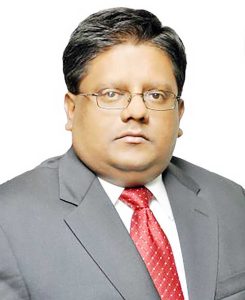Latest update November 25th, 2024 1:00 AM
Latest News
- ExxonMobil commences design for 7th project as Gov’t remains ‘iffy’ over approval
- Gov’t extends deadline for proposals on second phase of Gas-to-Energy project
- Hezbollah rockets land near Tel Aviv after big Israeli strike on Beirut
- 121 drivers nabbed speeding, 248 with unauthorised tinted glass
- Cop stabbed by Venezuelan national
Amaila Falls Hydro Project deal…Dr. Ashni Singh puts out 11-minute video defending project but silent on six most dangerous risks thrown on Guyana
Mar 02, 2022 News
Kaieteur News – Even as concerns continue to swell regarding the “controversial” Amaila Falls Hydroelectric Project (AFHP), specifically how exactly Guyanese will benefit from the multi-million project versus the risks, Senior Minister within the Office of the President with responsibility for Finance, Dr. Ashni Singh, on Monday evening issued an 11-minute video statement in defence of the project.
The Senior Minster attempted to create a picturesque image of what the re-imagined project will do for Guyana. But what was evidently absent from his defence was the six most dangerous risks the project throws on Guyana.
The plan to restart the “controversial” 165 megawatts (MW) AFHP comes more than a decade after millions of US dollars were spent to construct the first hydropower project at Amaila Falls, which never materialised.
Under the new deal, the Chinese operator – China Railway First Group – is expected to Build, Own, Operate and Transfer (BOOT) ownership of the plant to Guyana after 20 years. Under this model, the People’s Progressive Party/Civic (PPP/C) administration is claiming that Guyana will bear no risks. But Kaieteur News (KN) publisher, Glenn Lall, has urged citizens, via his radio programme called The Glenn Lall Show, to be vigilant about the ramifications of this project and the deal associated with it. Lall on the show said his warning in this regard is premised on a recent presentation by the Head of the project, Winston Brassington, at the International Energy Conference and Expo-2022 which was held at the Marriott Hotel.
In response to the KN Publisher’s word of caution to citizens via the radio show and newspaper articles, Dr. Singh thought it prudent to release a video response in defence of the project.
The Senior Minister, while speaking to State media, used 11 minutes to lash out at critics and expressed the government’s “grave disappointment at the campaign of misinformation that is being waged in relation to the major developmental project.”
Dr. Singh went on to talk about the project being backed by international experts, who carefully examined it. He stated too that pre-2014, the then PPP/C administration “had a major, large, credible international investor who was ready and willing to invest in this project.”
The senior minister said notwithstanding the willingness and readiness of the investor, the then APNU+AFC coalition used its one-seat majority while in opposition to “derail” and “frustrate” the project.
Now that the PPP/C is back in office, and is making rapid progress on the project, Dr. Singh said the “naysayers” are back with the same objective they had during the pre-2015 period, which is “to frustrate development and to make sure that the people of Guyana do not enjoy development.”
“We are firmly and unwaveringly committed to delivering development to the people of Guyana. Whether it is in energy infrastructures so that we can increase our electricity generation, reduce the cost of electricity generation, improve the reliability of electricity generation and distribution with a view to promoting not only lower electricity bills for people at home, but to lower electricity bills for investors who are dependent on electricity for their economic activity. Things like manufacturing enterprises, which will, in turn, generate jobs, create jobs for Guyanese people, generate incomes for Guyanese people,” Dr. Singh further noted.
While the Minister is bent on creating a quaint image of this project, with reference to only the project’s perceived “benefits”– he failed to inform the citizens about the six most dangerous risks the country faces with the said initiative.
During the energy conference that was held from February 15 to 18, 2022, Brassington gave attendees a glowing presentation on how much the US$700 million project to be built by the Chinese, will do for the country. He told those who gathered of how the project will significantly reduce the cost of electricity and how the Chinese will build it for less than the original cost which was calculated some 10 years ago.
The government’s spokesman and project head also claimed that Guyana will bear no risks in the operation of the project.
However, the reality is far from the dream that was sold to citizens. A perusal of Brassington’s entire presentation, in fact proves that what he told the attendees at the conference was not the entire story.
In fact, a closer look at Brassington’s PowerPoint presentation for the project by KN’s publisher, revealed massive risks for Guyana – none of which Brassington, nor the Senior Minister addressed.
During his presentation, Brassington only mentioned four risks, which the Chinese are expected to bear. The project head stated that the project is not going to cost Guyana any money and that Guyana stands to bear no risk. However, excerpts from his power-point presentation say otherwise.
According to excerpts from Brassington’s power point presentation, there are 10 primary project risks and mitigants that are expected.
Those namely are: construction cost, construction delays, geotechnical, hydrology, political force majeure (e.g. naturalization), other force majeure, Guyana Power and Light Incorporated (GPL) demand, GPL payment risk, interest rates, and Foreign Exchange (FX).
Stated below are the six risks that will be thrown on Guyana, and the remaining risks are the ones the Chinese contractor will bear.
HYDROLOGY
For the Hydrology risk, this simply means that GPL would bear the incurred liability whenever the Amaila Falls runs dry or if the 23 square kilometers reservoir is unable to feed the hydro plant. Hydrological risk is generally seen as the risk of having insufficient water in the source river or dam to support the expected levels of electricity generation as had been the case in the past with the Amaila Falls which runs dry during the course of the year.
As such, it would mean that in the event the falls run dry during the course of its hydro plant’s operation, GPL will have to assume all of the risk involved.
POLITICAL FORCE MAJEURE
For this risk, the Chinese contractor will obtain political risk insurance. This means that if for whatever reason there is political interference and the project is interrupted, the Chinese is covered by insurance and Guyana will have to pay the cost incurred to build the project.
OTHER FORCE MAJEURE
As it relates to the other force majeure, in the event of natural causes, both the government of Guyana and the Chinese contractor will bear the cause.
GPL
In this risk, in the event of the power being supplied by the Amaila Falls Hydro Project not being utilized, by GPL customers – the State entity and its customers stand to bear the risk.
GPL PAYMENT RISK
The GPL payment risk means that for whatever reason the revenue garnered by GPL is insufficient to meet payment obligations under a Power Purchase Agreement—currently being negotiated—then again the power company and its customers are the parties that would bear the risk and would have to meet any shortfall in payments to the Chinese contractor.
FOREIGN EXCHANGE (FX)
For this risk, Guyana is agreeing that all payments made to the Chinese contractor must be done in US dollars. This would impact Guyana negatively if and when exchange rate fluctuate, especially upwards.
CHINESE CONTRACTOR RISKS
Meanwhile, according to Brassington and his PowerPoint presentation – in addition to the other force majeure risk, which is also on Guyana – the risk the Chinese contractor bears is the construction cost, construction delays, and geotechnical.
For the construction risk that the Chinese contractor will bear, they will offset the expense to build the US$700 million project. However, it should be noted that according to the BOOT agreement, when the project comes on-stream Guyana will be purchasing electricity from the contractor for 20 years and thereafter the project will be transferred to the country.
As for the Geotechnical risk, this has to deal with the foundation that the project will be built on. While, Brassington was delighted to inform persons at the conference that the contractor will take this risk – he failed to mention that in 2012 Guyana paid to test the foundation of the Amaila Falls Project, so it is well known that the foundation can handle the project.
Share this:
- Click to print (Opens in new window)
- Click to email a link to a friend (Opens in new window)
- Click to share on Facebook (Opens in new window)
- Click to share on WhatsApp (Opens in new window)
- Click to share on Twitter (Opens in new window)
- Click to share on Pinterest (Opens in new window)
- Click to share on Pocket (Opens in new window)
- Click to share on Tumblr (Opens in new window)
- Click to share on Reddit (Opens in new window)
- Click to share on LinkedIn (Opens in new window)
Related
Similar Articles

The Glenn Lall Show | November, 20th, 2024
Follow on Tik Tok @Glennlall
THE BLUNT OF THE DAY

Sports
Nov 25, 2024
…Chase’s Academic Foundation remains unblemished Kaieteur Sports- Round six of the Republic Bank Under-18 Football League unfolded yesterday at the Ministry of Education ground, featuring...Features/Columnists
The business class also funds undemocratic parties
…Peeping Tom Kaieteur News- There’s a peculiar phenomenon in Guyana, a sort of cyclical ritual, where members of... more
Rising Gun Crimes in the Caribbean: Urgent Action required by all
By Sir Ronald Sanders Kaieteur News – There is an alarming surge in gun-related violence, particularly among younger... more
Publisher’s Note
Freedom of speech is our core value at Kaieteur News. If the letter/e-mail you sent was not published, and you believe that its contents were not libellous, let us know, please contact us by phone or email.
Feel free to send us your comments and/or criticisms.
Contact: 624-6456; 225-8452; 225-8458; 225-8463; 225-8465; 225-8473 or 225-8491.
Or by Email: [email protected] / [email protected]
Weekend Cartoon

















